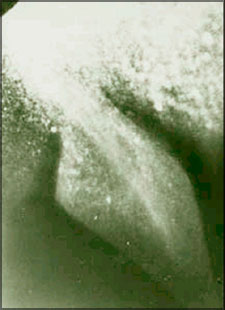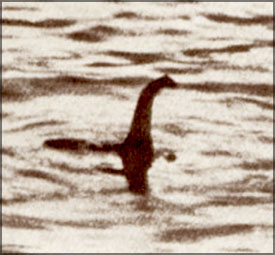|
observer |
|
|
|
|
|
OTHER LINKS |

|

|

|
Loch Ness MonsterNessie, or the Loch Ness Monster, is a mysterious and unidentified animal, or group of animals, claimed to inhabit the Scottish loch of Loch Ness, the largest freshwater loch in Great Britain by volume. Nessie is one of the best-known mysteries of cryptozoology along with Bigfoot and the Abominable Snowman. Current evidence supporting Nessie is found by most scientists and other experts to be unpersuasive, and regard the occasional reports of sightings as misidentification of known creatures or natural phenomena or hoaxes. However, many people around the world believe that Nessie exists, with the most popular theory being that it is a plesiosaur. The nickname "Nessie" sounds feminine, although no evidence exists to suggest the alleged creature's sex so the creature is often referred to as a female. The late Sir Peter Scott chose a scientific name for it, Nessiteras rhombopteryx which is much disputed. The name, based on Greek, means "the wonder of Ness with the diamond shaped fin". Rumors of a monster or animal living in the loch have been known for
several centuries, believers claim. Some Others question the accuracy or relevance of such tales. For example, an alleged sighting in October 1871 by a "D. Mackenzie", who supposedly described seeing something that moved slowly before moving off at a faster speed, has been repeated in several places, no original 1871 source for this report has been discovered, indicating that it may be an invention. Although sightings of the creature on land surrounding the loch are said to date back to the sixteenth century, modern interest in the monster was sparked by a sighting on 22 July 1933, when George Spicer and his wife saw 'a most extraordinary form of animal' cross the road in front of their car. They described the creature as having a large body (about 4 feet high and 25 feet long), and long, narrow neck, slightly thicker than an elephant's trunk and as long as the width of the road (about 10-12 feet wide); the neck had a number of undulations in it. They saw no limbs because of a dip in the road obscuring the animal's lower portion. It lurched across the road towards the loch 20 yards away, leaving only a trail of broken undergrowth in its wake. In a 1934 sighting Margaret Munro, a young girl working as a maid, observed the animal for 20 minutes. It was about 6.30 am on 5 June, and she saw it on the shore from a distance of about 200 yards. She said it had skin like an elephant's, a long neck, a small head and two short forelegs, or perhaps flippers. The sighting ended when it re-entered the water. Land sightings continued infrequently until 1963.
In December 1954 the fishing boat Rival III made another sonar contact. The crew observed sonar readings indicating a large object keeping pace with the boat at a depth of 480 feet. It was detected traveling for half a mile in this manner, before contact was lost. On June 17, 1993 Edna MacInnes, and David Mackay, both of Inverness, reportedly watched the monster for ten minutes. MacInnes described it as forty feet long, pale brown, and with a long neck held high out of the water. After swimming along the surface, it then sank into the water. Although the monster was a mile from the shore, MacInnes claimed she had to run along the shore to keep up with it. Forty minutes later they saw it again, and Mackay attempted to take a photograph, but only managed to get a picture of its wake. Later the same evening it was reportedly seen by James MacIntosh of Inverness along with his son, also named James. Young James saw it first, saying "Dad, that's not a boat." They also described a pale brown creature with a long neck; this time it was heading away from the shore. The third sighting that night was reported by Lorraine Davidson. She saw a large wake in the loch, when no boats were visible for miles. The wake also appeared to be different from a boat wake. One of the most iconic images of Nessie is known as the 'Surgeon's Photograph' and for many years was considered good evidence by believers in the monster, but has since been revealed as a hoax by one of its creators. The photo was confirmed as a hoax in the deathbed confession of Chris Spurling, son-in-law of Marmaduke Wetherell. Spurling claimed the photo was of a clay model attached to a toy submarine. Wetherell, a big game hunter, had been tricked into searching for an
imaginary monster around the loch In 2004, a documentary team for Channel 5 (primarily consisting of special effects experts from movies) deliberately tried to make people believe there was something in the loch. They constructed an elaborate animatronic model. Despite setbacks, it was a success, and numerous sightings were reported on the day, in the places they performed the hoaxes. In 2005 two students claimed to have found a tooth stuck in the body of a deer on the loch shore. They publicised the find widely, even setting up a website, but expert analysis soon revealed that the "tooth" was the antler of a muntjac (A kind of small deer). The most common description of Nessie, based on eyewitness accounts, is that of a plesiosaur, a long-necked aquatic reptile that became extinct. In defence of this theory, supporters cite the survival of a fish called the coelacanth, which supposedly went extinct at the same time as the plesiosaur but was rediscovered off the coast of Madagascar in 1938. Mainstream science cites several reasons why such an animal could not be alive in Loch Ness. Apart from the past extinction, the plesiosaur was a cold-blooded reptile; the average temperature of Loch Ness is about 5.5oC (42oF). Today's marine reptiles (crocodiles, sea turtles, and sea snakes) live in the tropics where the warm water can maintain their core body temperature. They also point out, should evidence be found to support the theory that plesiosaurs, like dinosaurs were warm-blooded, that they would need a large amount of food a day to maintain a level of activity that a warm-blooded animal requires. This, in turn, would cause more sightings. Other explanations for the sightings range from the mundane to the outrageous. One explanation which has increased in popularity in the early 21st century is that Nessie is some kind of large eel. Other animal candidates which have been suggested have been a large pike, sturgeon, dolphins, some kind of large mollusk including a large cephalopod, or nematode. Sightings have also been blamed on dogs, otters, and small birds. The Loch Ness Monster is a recurrent figure in modern literature, television movies and games. Nessie sometimes appears to represent Scotland almost as much as the Eiffel Tower does France. The common jibe that the monster helps the local tourist industry appears to be borne out in the appropriate websites (with one of the best monster websites, nessie.co.uk, being sponsored by a local hotel), although the defensive slogan "There's more to Inverness than Nessie" on one or two other sites perhaps shows that the monster is seen as a hindrance, rather than an opportunity, in some quarters. |
 have argued that a history of
monster sightings in the loch provides circumstantial evidence
supporting the creature's existence.
have argued that a history of
monster sightings in the loch provides circumstantial evidence
supporting the creature's existence.  In May 1943, C.B. Farrel of the Royal Observer Corps reported a
sighting of Nessie. He was about 250 yards away from it. He saw 20 or 30
feet of a body, and a neck held about 4-5 feet out of the water. It had
large eyes and the body seemed to have a 'fin'.
In May 1943, C.B. Farrel of the Royal Observer Corps reported a
sighting of Nessie. He was about 250 yards away from it. He saw 20 or 30
feet of a body, and a neck held about 4-5 feet out of the water. It had
large eyes and the body seemed to have a 'fin'.  based on evidence which turned out to
be the result of a children's prank. He was publicly ridiculed in the
Daily Mail, the journal which employed him. To get revenge, Marmaduke
Wetherell set this hoax up.
based on evidence which turned out to
be the result of a children's prank. He was publicly ridiculed in the
Daily Mail, the journal which employed him. To get revenge, Marmaduke
Wetherell set this hoax up. 








